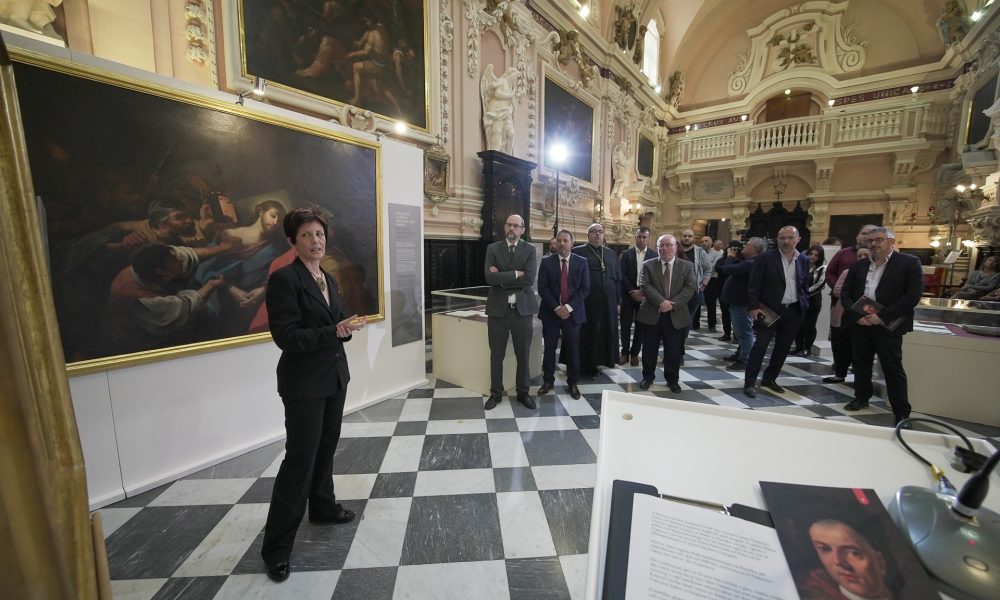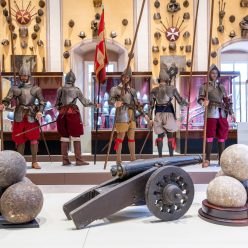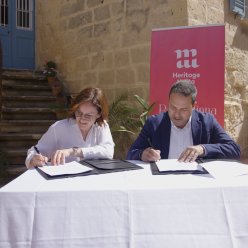by Daphne Sant Caruana and Warren Bugeja.
Closer to the heavens and the gods, birds in flight have always fascinated earth-bound humans. Invoking a sense of freedom and ambition, they have inspired Greek myths and aircraft engineers aspiring to reach the same lofty heights.
With their livelihood and chances of survival closely tied to favourable harvests, the ancients keenly observed the skies to determine when to sow and reap. The people that built the megalithic structures of Ġgantija were probably farmers who tilled the land with their livestock, living the rhythm of their lives in harmony with the passage of the seasons. Indeed, various bas-reliefs of animals found at Ħal Tarxien Prehistoric Complex lend credence to the theory that these monumental edifices hosted some form of communal rites associated with agricultural produce and seasonality.

The phenomenon of migration is captured for posterity in a sherd of Neolithic pottery, which originally formed part of a carinated bowl made of local clay. Created roughly around 5000 years ago, the fragment belongs to a period of heightened artistic activity in Maltese prehistory commonly referred to as the ‘Tarxien Phase’. This period is characterised by the creation of elaborate decorative schemes inside the megalithic monuments, figurative sculptural work and intensified ceramic production, which features a large variety of techniques and elegant decorative motifs. According to Daphne Sant Caruana, the Principal Curator for Ġgantija Archaeological Park, “This astonishing range of creative output reinforces the notion of a highly sophisticated and organised society with a strong sense of cultural identity.”

The fragment of pottery is decorated with a flying bird design that is singular because of its departure from other typical motifs that feature on Neolithic ceramic recipients in the national collection. “It captures the idea of a flock of birds flying in perfect synchrony so effectively,” Daphne enthuses. The birds are depicted flying in a formation of three parallel rows. Upon closer inspection, the lower birds appear to be larger and more deeply incised than the ones above. “In order to create a greater artistic effect and a deeper contrast, the grooves are also filled with a white paste” Daphne explains.

The sherd represents a direct link between a lost Neolithic race and modern-day bird watchers, a natural phenomenon that continues down the centuries to take place each year. Incredibly, It doesn’t take much detective work to elicit the identity of the birds in question.
“Although the design is highly stylised, we are still able to make an informed decision about the particular species of bird etched on the ceramic fragment. The prominent crests and sharp pointed tails in fact, suggest that they may be northern lapwings which migrate in flocks over the Maltese Islands during the winter months,” Caruana points out.

Daphne selected the ‘flying bird’ sherd as her artefact of choice for Heritage Malta’s HM TV series ‘Treasure To Meet You’ because “It represents the idea of beauty that transcends time.
Thousands of years ago, the inhabitants of Gozo wanted to capture the beauty of a flock of birds flying in perfect unison, possibly evoking the same emotional experience that still inspires our imagination today.”
The sherd was discovered quite by accident in 1954 when attempts were made to locate a curious Neolithic structure below the terrace boundary wall of Ġgantija that features prominently in an early 19th-century watercolour by the German-Danish artist Charles Frederick de Brocktorff. Although the ‘doorway’ was never discovered, archaeologists were rewarded by the discovery of this ceramic sherd.
Daphne believes that the carinated bowl would not have seen domestic service but rather have had a symbolic, ceremonial use as a signifier and marker of the changing seasons. Its significance lies not only in its aesthetic values but also because it brings into sharper focus the connection and understanding that people in the Neolithic had of the natural world. “I find it so remarkable that such a small artefact can tell us so much about people and, to some extent, even their values,” she states.
Watch the feature here in English or Maltese
‘Treasure to Meet You’ is uploaded to Heritage Malta’s Facebook page every fortnight on a Tuesday at 19:00. The intimate series consists of short features in both English and Maltese versions. Each fortnight, viewers get to meet one of our dedicated curators, who were asked to select an artefact or feature from the national collection to which they are particularly attached.
Latest News


Up Next
Press Releases | 2nd May 2023




